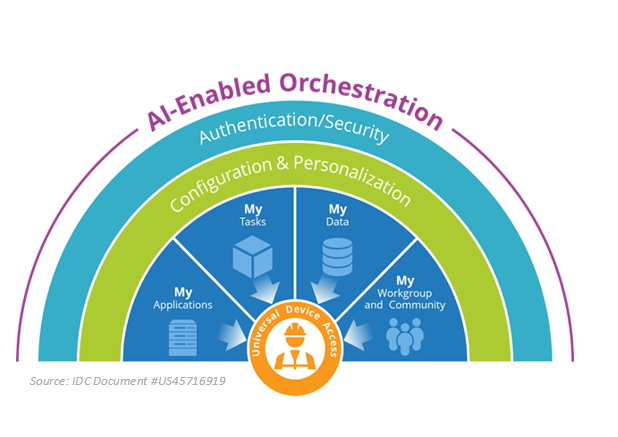While many organizations today are providing digital workspaces for their employees, some are not meeting the requirement of a truly digitally transformed work environment. These workspaces that are not up to par are inflexible workspaces. Inflexible workspaces are unable to sufficiently deliver an ideal employee experience, protect what matters most to an organization’s security, and effectively measure the impact of a technology initiative relative to overall business success.
IDC’s Future of Work framework defines the future workspace as a “connected, secure work environment, independent of place or time.” To realize the future workspace, IDC is guiding Chief Transformation Officers to collaborate with IT, lines of business, and HR to understand and apply the concept of the intelligent digital workspace.
What is an Intelligent Digital Workspace?
The intelligent digital workspace is where people, data, content, community and context meet with the technological solutions workers need to do their jobs. Any workflow or physical workspace which can incorporate digital technology can benefit from an intelligent workspace. Those businesses that do establish an intelligent digital workspace will flourish with the productivity and employee experience benefits that come from having it.
Breaking it Down: The Intelligent Digital Workspace

To simplify the complex nature of the intelligent digital workspace, let’s think of the workspace as a multi-layer property where the worker is the first layer and at the very core. Around that core are more layers working together to ease the burden carried by the core (or the human worker).
Universal Device Access acts as the second layer. It’s the initial interface to a digital layer of applications, tasks, data and workgroups and communities.
Workspace infrastructure is the third layer. Its job is to bind the interfaces, experiences and underlying data and business IP, which provide the guardrails, boundaries and security of the overall workspace.
Finally, AI, machine learning and analytics technologies are the fourth layer. These technologies proactively recommend the next best action and provide access to the resources required to complete that action.
Productivity and Worker Experience Benefits of the Intelligent Digital Workspace
When organizations apply the intelligent digital workspace to their workflows or workspaces, workers will benefit from an agile work experience. These benefits include:
- Minimized switching between different applications to get their job done
- Minimized interruptions and allowing the employee to deliver where their efforts have most impact
- Collaboration between digital and human workers to address opportunities as they emerge
- Leveraging AI/ML to identify next best action in each task
- Ease in accessing data, digital, physical, and social resources needed for them to work anywhere at anytime
Assessing Your Need for an Intelligent Digital Workspace
To begin your planning around the intelligent digital workspace, consider the following questions:
- Is employee experience at the center of your work transformation initiatives?
- Are your facilities keeping pace with a modern workplace strategy?
- How are you enabling employees in terms of productivity, collaboration, mobility?
Learn about the three other main challenges of work transformation – talent limitations, mis-adapted security privacy and trust, and hierarchical leadership – and how business leaders can address them.




